View in other NatureServe Network Field Guides
NatureServe
Montana
Utah
Wyoming
Idaho
Wisconsin
British Columbia
South Carolina
Yukon
California
New York
Burbot - Lota lota
Other Names:
Ling
State Rank Reason (see State Rank above)
Species is generally stable with declines and increases within some populations. Threats from alteration of the hydrology of occupied systems and entrapment within canals and ditches used for agriculture are the primary threats, but these appear to be low and unlikely to drive significant changes in these populations.
General Description
The burbot is easily recognized by its single chin barbel. It is native to most of Canada and the northern United States and is found in all three major river drainages in Montana. Burbot, also known as ling, are usually found in larger streams and cold, deep lakes and reservoirs. They are peculiar in that they spawn during winter, under the ice. They are also largely nocturnal and have an enthusiastic following among fishermen. Burbot are voracious predators and opportunistic feeders. Like other codfish, burbot have livers which contain oils high in vitamins A and D. Despite their unconventional appearance, fishermen rate burbot tops for table fare.
Diagnostic Characteristics
The skin of the burbot appears smooth, but tiny embedded scales are present.
Species Range
Montana Range
Range Descriptions
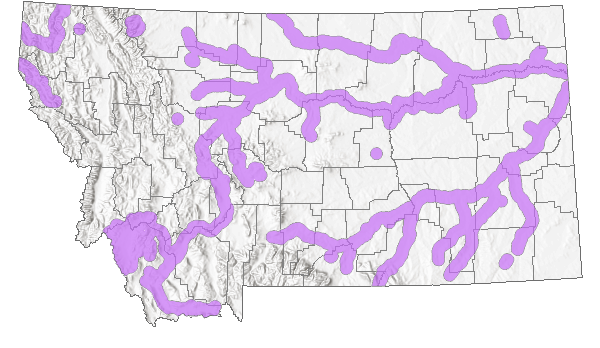
 Native
Native
Western Hemisphere Range
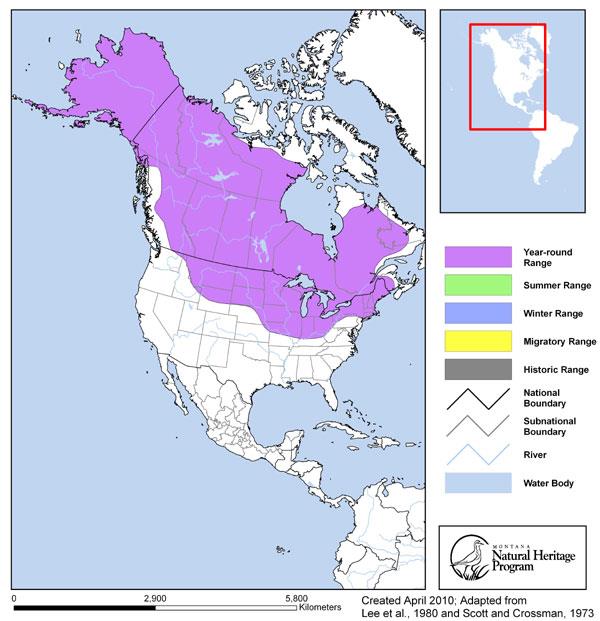
Range Comments
Burbot have circumpolar distribution above 40°N. Populations are continuous from the British Isles across Europe and Asia to the Bering Strait. In North America, burbot range from the Seward Peninsula in Alaska to New Brunswick along the Atlantic coast. Burbot are most common in streams and lakes of North America and Europe. They are fairly common in Lake Erie, but are also found in the other Great Lakes.
Observations in Montana Natural Heritage Program Database
Number of Observations: 3182
(Click on the following maps and charts to see full sized version)
Map Help and Descriptions
Relative Density
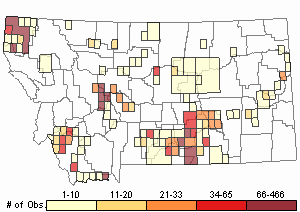
Recency
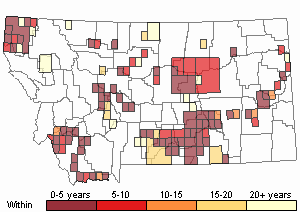

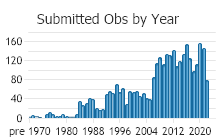
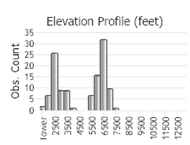 (Observations spanning multiple months or years are excluded from time charts)
(Observations spanning multiple months or years are excluded from time charts)
Migration
Burbot may move upstream to spawn in rivers where deep pools behind dams or diversions attract spawning groups.
Habitat
Burbot habitat includes large rivers and cold, deep lakes and reservoirs. They spawn in shallow water, usually in rocky areas.
Food Habits
The young feed on various aquatic invertebrates. Adults are very piscivorous.
Ecology
The lower Yellowstone River is a rearing area for young burbot.
Reproductive Characteristics
The species spawn from January to February in large groups. Eggs are cast over the bottom and hatch April through May. Incubation is for 30 days at 43 degrees F. Burbot are sexually mature in 3 years.
Stewardship Responsibility
References
- Literature Cited AboveLegend:
 View Online Publication
View Online Publication Lee, D.S., C.R. Gilbert, C.H. Hocutt, R.E. Jenkins, D. E. McAllister, J. R. Stauffer, Jr. 1980. Atlas of North American freshwater fishes. North Carolina State Musuem of Natural History. 867 p.
Lee, D.S., C.R. Gilbert, C.H. Hocutt, R.E. Jenkins, D. E. McAllister, J. R. Stauffer, Jr. 1980. Atlas of North American freshwater fishes. North Carolina State Musuem of Natural History. 867 p. Scott, W.B. and E.J. Crossman. 1973. Rainbow trout, Kamloops trout, Steelhead trout Salmo gairdneri Richardson. pp. 184-191. In: Freshwater fishes of Canada. Ottawa, Canada: Fisheries Research Board of Canada, Bulletin 184. 966 p.
Scott, W.B. and E.J. Crossman. 1973. Rainbow trout, Kamloops trout, Steelhead trout Salmo gairdneri Richardson. pp. 184-191. In: Freshwater fishes of Canada. Ottawa, Canada: Fisheries Research Board of Canada, Bulletin 184. 966 p.
- Additional ReferencesLegend:
 View Online Publication
View Online Publication
Do you know of a citation we're missing? Craig, V.E. 1952. A story of fish production as it applies to Montana. M.Sc. Thesis. Bozeman, MT: Montana State University. 92 p.
Craig, V.E. 1952. A story of fish production as it applies to Montana. M.Sc. Thesis. Bozeman, MT: Montana State University. 92 p. Dieterman, D.J., M.P. Ruggles, M.L. Wildhaber, and D.L. Galat (eds). 1996. Population structure and habitat use of benthic fishes along the Missouri and Lower Yellowstone Rivers. 1996 Annual report of Missouri River Benthic Fish Study PD-95-5832 to U.S. Army Corps of Engineers and U.S. Bureau of Reclamation. 238 p.
Dieterman, D.J., M.P. Ruggles, M.L. Wildhaber, and D.L. Galat (eds). 1996. Population structure and habitat use of benthic fishes along the Missouri and Lower Yellowstone Rivers. 1996 Annual report of Missouri River Benthic Fish Study PD-95-5832 to U.S. Army Corps of Engineers and U.S. Bureau of Reclamation. 238 p. Duncan, M.B. 2019. Distributions, abundances, and movements of small, nongame fishes in a large Great Plains river network. Ph.D. Dissertation. Bozeman, MT: Montana State University. 255 p.
Duncan, M.B. 2019. Distributions, abundances, and movements of small, nongame fishes in a large Great Plains river network. Ph.D. Dissertation. Bozeman, MT: Montana State University. 255 p. Gangloff, M.M. 1996. Winter habitat and distribution of Artic Grayling in Upper Red Rock Lake, Red Rock Lakes National Wildlife Refuge, Montana. M.Sc. Thesis. Bozeman, MT: Montana State University. 101p.
Gangloff, M.M. 1996. Winter habitat and distribution of Artic Grayling in Upper Red Rock Lake, Red Rock Lakes National Wildlife Refuge, Montana. M.Sc. Thesis. Bozeman, MT: Montana State University. 101p. Holton, G.D. 1981. Identification of Montana's most common game and sport fishes. Montana Outdoors May/June reprint. 8 p.
Holton, G.D. 1981. Identification of Montana's most common game and sport fishes. Montana Outdoors May/June reprint. 8 p. Joslin, Gayle, and Heidi B. Youmans. 1999. Effects of recreation on Rocky Mountain wildlife: a review for Montana. [Montana]: Montana Chapter of the Wildlife Society.
Joslin, Gayle, and Heidi B. Youmans. 1999. Effects of recreation on Rocky Mountain wildlife: a review for Montana. [Montana]: Montana Chapter of the Wildlife Society. Katzman, L.A. 1998. Effects of predation on status of Arctic grayling at Red Rock Lakes National Wildlife Refuge, Montana. M.Sc. Thesis. Bozeman, MT: Montana State University. 207 p.
Katzman, L.A. 1998. Effects of predation on status of Arctic grayling at Red Rock Lakes National Wildlife Refuge, Montana. M.Sc. Thesis. Bozeman, MT: Montana State University. 207 p. Lance, M.J. 2019. Spatial and temporal variability in movements and vital rates of sympatric salmonids in an unfragmented, inland watershed. M.Sc. Thesis. Bozeman, MT: Montana State University. 116 p.
Lance, M.J. 2019. Spatial and temporal variability in movements and vital rates of sympatric salmonids in an unfragmented, inland watershed. M.Sc. Thesis. Bozeman, MT: Montana State University. 116 p. McDonald, K. 2003. Burbot Status Assessment, Project Performance Report, February 3, 2003 through December 31, 2003
McDonald, K. 2003. Burbot Status Assessment, Project Performance Report, February 3, 2003 through December 31, 2003 McDonald, K. 2004. Burbot Status Assessment, Project Performance Report, April 5, 2004 through December 31, 2004.
McDonald, K. 2004. Burbot Status Assessment, Project Performance Report, April 5, 2004 through December 31, 2004. Mogen, J.T. 1996. Status and biology of the spawning population of Red Rock Lakes Arctic grayling. M.Sc. Thesis. Bozeman, MT: Montana State University. 90 p.
Mogen, J.T. 1996. Status and biology of the spawning population of Red Rock Lakes Arctic grayling. M.Sc. Thesis. Bozeman, MT: Montana State University. 90 p. Montana Department of Fish, Wildlife and Parks. 1989. Northeast Montana Warmwater Ecosystem Investigations: project period 7/1/88 through 6/30/89. Proj.# F-46-R-2; Job# V-e. 21p.
Montana Department of Fish, Wildlife and Parks. 1989. Northeast Montana Warmwater Ecosystem Investigations: project period 7/1/88 through 6/30/89. Proj.# F-46-R-2; Job# V-e. 21p. Montana Fish, Wildlife and Parks. 1989. Hauser Reservoir fisheries management plan: September 1989-September 1994. 16 p.
Montana Fish, Wildlife and Parks. 1989. Hauser Reservoir fisheries management plan: September 1989-September 1994. 16 p. Mullins, M.S. 1991. Biology and predator use of cisco (Coregonus artedi) in Fort Peck Reservoir, Montana. M.Sc. Thesis. Bozeman, MT: Montana State University. 68 p.
Mullins, M.S. 1991. Biology and predator use of cisco (Coregonus artedi) in Fort Peck Reservoir, Montana. M.Sc. Thesis. Bozeman, MT: Montana State University. 68 p. Nelson, P.H. 1953. Life history and management of the American Grayling (Thymallus signifer tricolor) in Montana. M.Sc. Thesis. Bozeman, MT: Montana State University. 45 p.
Nelson, P.H. 1953. Life history and management of the American Grayling (Thymallus signifer tricolor) in Montana. M.Sc. Thesis. Bozeman, MT: Montana State University. 45 p. Purkett, C.A. Jr. 1950. A comparative growth rate of trout in relation to elevation and temperature. M.Sc. Thesis. Bozeman, MT: Montana State University. 33 p.
Purkett, C.A. Jr. 1950. A comparative growth rate of trout in relation to elevation and temperature. M.Sc. Thesis. Bozeman, MT: Montana State University. 33 p. Sando, S.K. 1981. The spawning and rearing habitats of rainbow trout and brown trout in two rivers Montana. M.Sc. Thesis. Bozeman, MT: Montana State University. 67 p.
Sando, S.K. 1981. The spawning and rearing habitats of rainbow trout and brown trout in two rivers Montana. M.Sc. Thesis. Bozeman, MT: Montana State University. 67 p. Schultz, L.P. 1941. Fishes of Glacier National Park, Montana. USDI Conservation Bulletin No. 22. Washington D.C.: US Government Printing Office. 42 p.
Schultz, L.P. 1941. Fishes of Glacier National Park, Montana. USDI Conservation Bulletin No. 22. Washington D.C.: US Government Printing Office. 42 p. Spinelli, J.P. 2010. Spatial and temporal entrainment of fish from Hauser Reservoir, Montana. M.Sc. Thesis. Bozeman, Montana: Montana State University. 107 p.
Spinelli, J.P. 2010. Spatial and temporal entrainment of fish from Hauser Reservoir, Montana. M.Sc. Thesis. Bozeman, Montana: Montana State University. 107 p. Stash, S.W. 2001. Distribution, relative abundance, and habitat associations of Milk River fishes related to irrigation diversion dams. M.Sc. Thesis. Bozeman, MT: Montana State University. 82 p.
Stash, S.W. 2001. Distribution, relative abundance, and habitat associations of Milk River fishes related to irrigation diversion dams. M.Sc. Thesis. Bozeman, MT: Montana State University. 82 p. Stefanich, F.A. 1951. The population and movement of fish in Prickley Pear Creek, Montana. M.Sc. Thesis. Bozeman, Montana: Montana State University. 42 p.
Stefanich, F.A. 1951. The population and movement of fish in Prickley Pear Creek, Montana. M.Sc. Thesis. Bozeman, Montana: Montana State University. 42 p. Stevenson, H.R. 1975. The trout fishery of the Bighorn River below Yellowtail Dam, Montana. M.Sc. Thesis. Bozeman, MT: Montana State University. 67 p.
Stevenson, H.R. 1975. The trout fishery of the Bighorn River below Yellowtail Dam, Montana. M.Sc. Thesis. Bozeman, MT: Montana State University. 67 p. Stringer, A.L. 2018. Status of Northern Pearl Dace and chrosomid dace in prairie streams of Montana. M.Sc. Thesis. Bozeman, MT: Montana State University. 150 p.
Stringer, A.L. 2018. Status of Northern Pearl Dace and chrosomid dace in prairie streams of Montana. M.Sc. Thesis. Bozeman, MT: Montana State University. 150 p. Sylvester, R. and B. Marotz. 2006. Evaluation of the Biological Effects of the Northwest Power Conservation Council's Mainstem Amendment on the Fisheries Upstream and Downstream of Hungry Horse and Libby Dams, Montana. Montana Fish, Wildlife, and Parks Annual Report prepared for U.S. Department of EnergyBonneville Power Administration. Bonneville Power Administration Project No. 2006-008-00 Contract No. 28350. 124 p.Contract No. 28350
Sylvester, R. and B. Marotz. 2006. Evaluation of the Biological Effects of the Northwest Power Conservation Council's Mainstem Amendment on the Fisheries Upstream and Downstream of Hungry Horse and Libby Dams, Montana. Montana Fish, Wildlife, and Parks Annual Report prepared for U.S. Department of EnergyBonneville Power Administration. Bonneville Power Administration Project No. 2006-008-00 Contract No. 28350. 124 p.Contract No. 28350 Sylvester, R. and B. Stephens. 2011. Evaluation of the physical and biological effects of the Northwest Power Conservation Council's Mainstem Amendment upstream and downstream of Libby Dam, Montana. Libby, MT: Montana Fish, Wildlife, and Parks Annual Report prepared for U.S. Department of Energy Bonneville Power Administration. Bonneville Power Administration Project No. 2006-008-00, Contract Nos. 43309 and 48555. 282 p.
Sylvester, R. and B. Stephens. 2011. Evaluation of the physical and biological effects of the Northwest Power Conservation Council's Mainstem Amendment upstream and downstream of Libby Dam, Montana. Libby, MT: Montana Fish, Wildlife, and Parks Annual Report prepared for U.S. Department of Energy Bonneville Power Administration. Bonneville Power Administration Project No. 2006-008-00, Contract Nos. 43309 and 48555. 282 p. Sylvester, R., A. Steed, J. Tohtz, and B. Marotz. 2008. Evaluation of the Biological Effects of the Northwest Power Conservation Council's Mainstem Amendment on the Fisheries Upstream and Downstream of Hungry Horse and Libby Dams, Montana. Montana Fish, Wildlife, and Parks Annual Report prepared for U.S. Department of EnergyBonneville Power Administration. Bonneville Power Administration Project No. 2006-008-00 Contract No. 28350. 124 p.Contract No. 28350
Sylvester, R., A. Steed, J. Tohtz, and B. Marotz. 2008. Evaluation of the Biological Effects of the Northwest Power Conservation Council's Mainstem Amendment on the Fisheries Upstream and Downstream of Hungry Horse and Libby Dams, Montana. Montana Fish, Wildlife, and Parks Annual Report prepared for U.S. Department of EnergyBonneville Power Administration. Bonneville Power Administration Project No. 2006-008-00 Contract No. 28350. 124 p.Contract No. 28350 Sylvester, R.M., J.T. Frye, C.R. Gabreski, M.A. Webb, and H.C. Glassic. 2021. Kootenai River white sturgeon Acipenser transmontanus: 2009-2020 investigations in Montana. Montana Fish, Wildlife & Parks for the United States Fish & Wildlife Service Permit TE-210255-2. 87 p.
Sylvester, R.M., J.T. Frye, C.R. Gabreski, M.A. Webb, and H.C. Glassic. 2021. Kootenai River white sturgeon Acipenser transmontanus: 2009-2020 investigations in Montana. Montana Fish, Wildlife & Parks for the United States Fish & Wildlife Service Permit TE-210255-2. 87 p. Trenka, R.J. 2000. Community structure and habitat associations of fishes of the lower Tongue and Powder Rivers. M.Sc. Thesis. Bozeman, MT: Montana State University. 85 p.
Trenka, R.J. 2000. Community structure and habitat associations of fishes of the lower Tongue and Powder Rivers. M.Sc. Thesis. Bozeman, MT: Montana State University. 85 p. Triano, B.L. 2020. Attraction, entrance, and passage efficiency of Arctic Grayling, trout, and suckers at Denil fishways in the Big Hole River basin, Montana. M.Sc. Thesis. Bozeman, MT: Montana State University. 67 p.
Triano, B.L. 2020. Attraction, entrance, and passage efficiency of Arctic Grayling, trout, and suckers at Denil fishways in the Big Hole River basin, Montana. M.Sc. Thesis. Bozeman, MT: Montana State University. 67 p. USDI Bureau of Land Management. No date. Fishes of the Miles city, Montana BLM District. Miles City, MT: Miles City BLM District pamphlet. 12 p.
USDI Bureau of Land Management. No date. Fishes of the Miles city, Montana BLM District. Miles City, MT: Miles City BLM District pamphlet. 12 p. Young, B.A., T.L. Welker, M.L. Wildhaber, C.R. Berry, and D. Scarnecchia (eds). 1997. Population structure and habitat use of benthic fishes along the Missouri and Lower Yellowstone Rivers. 1997 Annual report of Missouri River Benthic Fish Study PD-95-5832 to U.S. Army Corps of Engineers and U.S. Bureau of Reclamation. 207 p.
Young, B.A., T.L. Welker, M.L. Wildhaber, C.R. Berry, and D. Scarnecchia (eds). 1997. Population structure and habitat use of benthic fishes along the Missouri and Lower Yellowstone Rivers. 1997 Annual report of Missouri River Benthic Fish Study PD-95-5832 to U.S. Army Corps of Engineers and U.S. Bureau of Reclamation. 207 p.
- Web Search Engines for Articles on "Burbot"
- Additional Sources of Information Related to "Fish"





